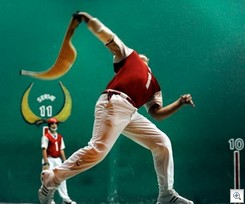 Jai Alai is a game that is played on the basic principles used for handball and racquetball games. Jai alai contests are used for pari-mutuel betting in Florida, Connecticut, and Rhode Island and for almost a decade in the MGM casinos of Las Vegas and Reno, Nevada.
Jai Alai is a game that is played on the basic principles used for handball and racquetball games. Jai alai contests are used for pari-mutuel betting in Florida, Connecticut, and Rhode Island and for almost a decade in the MGM casinos of Las Vegas and Reno, Nevada.
The game is considered the oldest ball game played today; it is also considered the fastest game played. Players either compete as individuals or in teams of two. The game is played on a very large court, 177 feet long, 55 feet wide, and 55 feet high. The playing facility is called a fronton. The ball is very hard – harder than a golf ball – and is about three-fourths the size of a baseball. The ball, called a pelota, is propelled by the players toward the front wall of the court. The players hold a cesta, which is a curved basket that extends from one of their arms. They catch the ball in the basket device and then without letting it settle, they propel it back to the front wall. They must retrieve and return the ball before it hits the floor two times. The balls may move as fast as 150 miles per hour in the games, faster than any other ball in any game.
The game of jai alai may have had ancient predecessors, as the notions behind handball have been found in many prehistoric societies. In its present form, however, the game is traced to Basque villages in the Pyrenees of France and Spain. The origins of the game may go back to the fifteenth century. Mythmakers suggest that the game may have been the invention of St. Ignatius of Loyola, who – like his compatriot St. Francis Xavier – was Basque. What is less mythical is the fact that the game was played during religious festival occasions in the Catholic region. The words jai alai mean “merry festival”. The game has also been known as pelota vasca or Basque vall. The game is celebrated in the classic art of Spain. Francisco Goya created a tapestry called Game of Pelota for the Prado in Madrid. Many mythical heroic characters of Basque tradition were pelota players.
As the Basques and persons from the surrounding regions migrated to the Western Hemisphere, they brought the game with them. It came to Cuba by the beginning of the twentieth century, and it was displayed at the St. Louis World’s Fair of 1904. (Castro closed down games in 1960 as he closed the Cuban casinos). It came to Florida in 1924. Although the game enjoyed some natural popularity for its basic excitement, it did not draw large crowds until 1937, when the Florida legislature authorized pari-mutuel betting on the winners of the games.
In the jai alai game there are eight players (or eight teams of two players each). They play round robin matches. A player (team) who wins a point remains in the game; the loser is replaced with another player (team). They keep playing until one player (team) has scored seven points. In a sweep, one player could score seven straight points but would have to do so by scoring against every other team in the contest. The contests result in one winner with seven points and second- and third-place players (teams) with the next highest number of points. If there is a tie, the tying teams play off for their position. Those making wagers can bet the basic win, place, and show as in horse racing. Jai alai contests also were innovative because they created the quinella, perfecta, and exacta bets. A trifecta bet is also used.
Florida developed many frontons, but play levels pale in comparison with other betting venues such as bingo halls, horse tracks, and Native American casinos. The MGM Grand Hotels of Las Vegas and Reno had frontons until the mid-1980s. Connecticut authorized jai alai betting in the early 1970s, as did Rhode Island in 1976. Efforts to get the sport accepted elsewhere in North America for pari-mutuel wagering have not been successful.
<
|
|